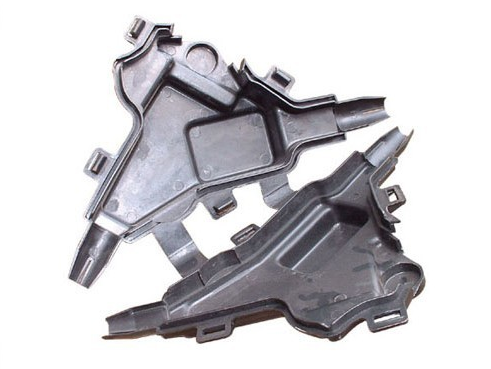1)抗拉強度和屈服強度
1) Tensile strength and yield strength
不同類型的模具對鍛造模具材料所要求的力學性能具體指標有所側重,同時不應僅考慮室溫力學性能而忽視更重要的實際工作溫度的性能指標;切忌追求盲目脫離實際的全面高指標。例如:在冷鍛變形抗力極高的難變形合金鍛件時,當模具承受的應力超過鍛造模具材料在使用溫度下的抗拉強度時,會導致模具開裂報廢;如果模具承受的應力超過鍛造模具材料在使用溫度下的屈服強度時,則會引起模具塌陷等永久變形,導致鍛件超差。在這種條件下,就要選擇抗拉強度和屈服強度高的鍛造模具材料,一般,鍛造模具材料的抗拉強度應大于應承受應力的30%以上。
Different types of dies focus on the specific mechanical properties required by forging die materials. At the same time, we should not only consider the mechanical properties at room temperature and ignore the more important performance indexes at actual working temperature; Do not pursue comprehensive high indicators that are blindly divorced from reality. For example, in the case of hard to deform alloy forgings with high cold forging deformation resistance, when the stress borne by the die exceeds the tensile strength of the forging die material at the service temperature, the die will be cracked and scrapped; If the stress borne by the die exceeds the yield strength of the forging die material at the service temperature, permanent deformation such as die collapse will be caused, resulting in out of tolerance of the forging. Under this condition, forging die materials with high tensile strength and yield strength should be selected. Generally, the tensile strength of forging die materials should be greater than 30% of the stress.
2)沖擊韌性、斷面收縮率和延伸率
2) Impact toughness, reduction of area and elongation
由于鍛造模具材料的沖擊韌性指標的選擇與鍛造載荷性質密切相關,因此,對于鍛錘和螺旋壓力機等沖擊載荷設備使用的模具,如果鍛造模具材料的沖擊韌性低,模具有可能發生開裂而報廢;在這種條件下,就要選擇沖擊韌性高的鍛造模具材料。
Because the selection of impact toughness index of forging die material is closely related to the properties of forging load, for the dies used by impact load equipment such as forging hammer and screw press, if the impact toughness of forging die material is low, the dies may crack and be scrapped; Under this condition, forging die materials with high impact toughness should be selected.
對于斷面收縮率和延伸率高的鍛造模具材料,可以在出現微小裂紋的情況下繼續使用,而不致于很快就破裂,因此,在抗拉強度、屈服強度和硬度指標許可條件下,盡可能地提高其斷面收縮率和延伸率。

For forging die materials with high area shrinkage and elongation, they can continue to be used in the case of small cracks without breaking soon. Therefore, under the permission of tensile strength, yield strength and hardness indexes, the area shrinkage and elongation shall be improved as much as possible.
3)硬度
3) Hardness
鑒于硬度除了與強度指標有對應關系外,還與模具的耐磨性密切相關,在沖擊韌性、斷面收縮率和延伸率等指標許可條件下,盡可能地提高其硬度(或耐磨性)。鍛模硬度和紅硬性是鍛模材料的重要性能,模具在高溫下工作應能保持其形狀和尺寸不發生變化。
In view of the fact that the hardness is not only related to the strength index, but also closely related to the wear resistance of the die, the hardness (or wear resistance) shall be improved as much as possible under the allowable conditions of impact toughness, reduction of area and elongation. The hardness and red hardness of forging die are important properties of forging die materials. The die should be able to keep its shape and size unchanged when working at high temperature.
眾所周知,同一個鍛造模具材料的抗拉強度、屈服強度、硬度和斷面收縮率、延伸率、沖擊韌性之間存在著相互矛盾的關系,如果提高前者,必須要犧牲后者,這就需要根據具體模具的實際工作環境來選擇相應的性能匹配。
As we all know, there is a contradictory relationship between the tensile strength, yield strength, hardness, reduction of area, elongation and impact toughness of the same forging die material. If the former is improved, the latter must be sacrificed, which requires the corresponding performance matching to be selected according to the actual working environment of the specific die.
必須指出,材料的硬度在一定程度不但可以反映強度水平,而且硬度和耐磨性有著甘種對應關系,一般硬度高的材料,其耐磨性也好,因此,許多鍛造模具材料通常只簡單地規定對硬度的要求。
It must be pointed out that the hardness of materials can not only reflect the strength level to a certain extent, but also have a corresponding relationship between hardness and wear resistance. Generally, materials with high hardness have good wear resistance. Therefore, many forging die materials usually only simply specify the requirements for hardness.
2.疲勞性能
2. Fatigue performance
鍛造模具材料的疲勞性能包括機械疲勞和冷熱疲勞兩種。熱作模具長期在高機械載荷至零機械載荷及200℃~600℃溫度區間交替循環,這兩種脈沖的加載和卸載所造成應力的疊加,久而久之,模膛表面會萌生出微裂紋;微裂紋進一步發展就會加速模具磨損、產生碎塊,從而導致模具失效,所以要求鍛造模具材料應該具有良好的抗機械疲勞和抗冷熱疲勞性能。
The fatigue properties of forging die materials include mechanical fatigue and cold and hot fatigue. The hot working die circulates alternately from high mechanical load to zero mechanical load and 200 ℃ ~ 600 ℃ temperature range for a long time. The superposition of stress caused by loading and unloading of these two pulses will cause microcracks on the surface of the die bore over time; The further development of microcracks will accelerate die wear and produce fragments, resulting in die failure. Therefore, it is required that the forging die material should have good mechanical fatigue resistance and cold and hot fatigue resistance.
